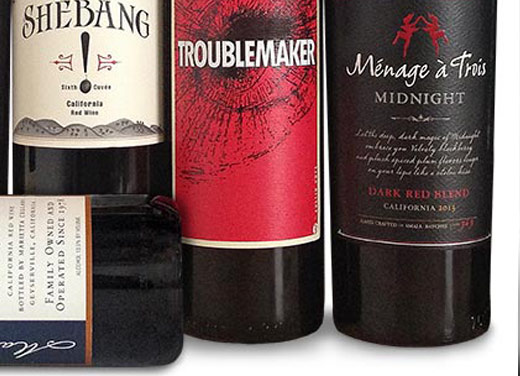What is the Next Big Thing?
BY: Warren Dennis
“What is the Next Big thing?” That is the question everyone is asking these days in the wine business. The most recent trend to come and go was the “it’s okay to drink sweet” revolution focusing on Moscato, but more recently I have noticed a turn away from sweet towards fat, lush, full-bodied Red Blends. Some people give Napa Valley’s Folie à Deux “Ménage à Trois” or Marietta Cellars “Old Vine Lot Series” credit for starting the blending phenomenon.

But, the truth is, Old World Europe may have started this blend trend in the mid 1970’s when irreverent Italian winemaker, Piero Antinori, broke the law and created a style we now know as “Super Tuscan” – a luscious Red Blend that often passes the $100/bottle threshold. At a time when wines of the Chianti region of Tuscany were required to have 90% or more of the Sangiovese varietal, Antinori blended and oak-aged Sangiovese and Cabernet grapes to create a luscious blend that shook wine culture worldwide.
Here at Beverage Superstore Suwanee, we used to have one rack of Red Blends and for years that was plenty. But, in the last two years there have been so many new, high quality versions of Red Blends emerging into the market that we’ve had to go so far as to subdivide them into different types. We have several that are Zinfandel-based, like Bedrock’s “Shebang” or Austin Hope’s “Troublemaker” which are comfortably priced in the $10-$15 range, or Prisoner Wine Company’s namesake Red Blend at $39.99 for a step-up. The other main subsets are Bordeaux-styled blends, including Meritage or Clarets like California-produced Francis Coppola “Diamond Series” and Bonny Doon’s “A Proper Claret.”
While blending is growing in popularity, most countries and specific regions, do regulate the grape varieties that winemakers are allowed to use. For instance, a true Bordeaux wine must be produced in the Bordeaux region of France and is limited to five grape varieties: Cabernet Sauvignon, Merlot, Cabernet Franc, Malbec and Petite Verdot. In the US, most Bordeaux-style wine consists of those time-tested five grape varieties, but often includes a little Syrah for bigger body.
The truth is, blending makes sense. Whether it’s an inexpensive, entry-level bottle or an elite Napa cult Cabernet setting you back a few hundred dollars, adding a second grape can add great complexity or improve the overall structure of the wine.

So, while the blend trend is nothing new, it certainly is gaining popularity lately! Think of a red blend as “the little black dress” of the wine world – a classic that you’ve gotta have in your {wine} closet! The way today’s winemakers are making blends gives a new twist on old ideas. With more and more people beginning to explore the world of wine, we can now all raise our glasses to The Next Big Thing and pour ourselves a glass of a lush, blended red. Napa cult Cabernet setting you back a few hundred dollars, adding a second grape can add great complexity or improve the overall structure of the wine. Luckily, winemakers everywhere have embraced this idea.
However, in the last two years there have been so many new, high quality versions of Red Blends emerging into the market that I have had to go so far as to subdivide them into different types. We have several that are Zinfandel-based, like Bedrock’s “Shebang” or Austin Hope’s “Troublemaker” which are comfortably priced in the $10-$15 range, or Prisoner Wine Company’s namesake Red Blend at $39.99 for a step-up. The other main subset is Bordeaux-style blends, including the US-made Francis Coppola “Diamond Collection” and Bonny Doon “Proper Claret”. Many wines are “Bordeaux-inspired” but those produced in Bordeaux, by French law, are limited to using their five traditional grape varieties – Cabernet Sauvignon, Merlot, Cabernet Franc, Malbec and Petite Verdot. In the US, most red blends consist of those time-tested, world-renowned five grapes, but often include a little Syrah for bigger body.
Many countries, in fact, do regulate the grape varieties that winemakers are allowed to use for quality assurance and proper labeling. In Barolo and Barbaresco, both in Italy’s Piedmont region, they are limited to using the renowned Nebbiolo grape – known for producing some of the biggest, most full-bodied red wines in the world. In Italy, wines from the Chianti region of central Tuscany must contain 90% or more of the Sangiovese grape, while their hilltop neighbor, the Tuscan village of Montalcino, produces the world-renowned, prestigious Brunello di Montalcino wines exclusively from Sangiovese grapes grown on their village’s slopes. But, in the mid-1970’s an irreverent Italian winemaker named Piero Antinori, rattled Tuscany and its beloved Sangiovese vineyards when he created “Tignanello” by blending and oak-aging Cabernet with classic Sangiovese – creating a luscious and sensational blend we now know as “Super Tuscan”. These often pass the $100/bottle threshold and reach iconic stature with the world’s greatest wines.
So, while the blend trend is nothing new, it certainly is gaining popularity lately! Think of a red blend as “the little black dress” of the wine world – a classic that you’ve gotta have in your {wine} closet! The way today’s winemakers are making blends gives a new twist on old ideas. With more and more people beginning to explore the world of wine, we can now all raise our glasses to The Next Big Thing and pour ourselves a glass of a lush, blended red.













